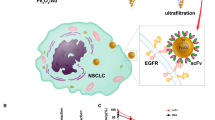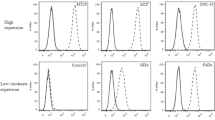Abstract
Purpose
Overexpression of epithelial cell adhesion molecule (EpCAM) plays essential roles in tumorigenesis and tumor progression in almost all epithelium-derived cancer. Monitoring EpCAM expression in tumors can be used for the diagnosis, staging, and prognosis of cancer patients, as well as guiding the individualized treatment of EpCAM-targeted drugs. In this study, we described the synthesis and evaluation of a site-specifically [99mTc]Tc-labeled EpCAM-targeted nanobody for the SPECT/CT imaging of EpCAM expression.
Methods
We first prepared the [99mTc]Tc-HYNIC-G4K; then, it was site-specifically connected to EpCAM-targeted nanobody NB4. The in vitro characteristics of [99mTc]Tc-NB4 were investigated in HT-29 (EpCAM positive) and HL-60 (EpCAM negative) cells, while the in vivo studies were performed using small-animal SPECT/CT in the subcutaneous tumor models and the lymph node metastasis model to verify the specific targeting capacity as well as the potential applications of [99mTc]Tc-NB4.
Results
[99mTc]Tc-NB4 displayed a high EpCAM specificity both in vitro and in vivo. SPECT/CT imaging revealed that [99mTc]Tc-NB4 was cleared rapidly from the blood and normal organs except for the kidneys, and HT-29 tumors were clearly visualized in contrast with HL-60 tumors. The uptake value of [99mTc]Tc-NB4 in HT-29 tumors was increased continuously from 3.77 ± 0.39%ID/g at 0.5 h to 5.53 ± 0.82%ID/g at 12 h after injection. Moreover, the [99mTc]Tc-NB4 SPECT/CT could clearly image tumor-draining lymph nodes.
Conclusion
[99mTc]Tc-NB4 is a broad-spectrum, specific, and sensitive SPECT radiotracer for the noninvasive imaging of EpCAM expression in the epithelium-derived cancer and revealed a great potential for the clinical translation.






Similar content being viewed by others
References
Baeuerle P, Gires O. EpCAM (CD326) finding its role in cancer. Br J Cancer. 2007;96:417–23.
Litvinov S, Balzar M, Winter M, Bakker H, Briaire-de Bruijn I, Prins F, et al. Epithelial cell adhesion molecule (Ep-CAM) modulates cell-cell interactions mediated by classic cadherins. J Cell Biol. 1997;139:1337–48.
Went P, Lugli A, Meier S, Bundi M, Mirlacher M, Sauter G, et al. Frequent EpCam protein expression in human carcinomas. Hum Pathol. 2004;35:122–8.
Went P, Vasei M, Bubendorf L, Terracciano L, Tornillo L, Riede U, et al. Frequent high-level expression of the immunotherapeutic target Ep-CAM in colon, stomach, prostate and lung cancers. Br J Cancer. 2006;94:128–35.
Spizzo G, Went P, Dirnhofer S, Obrist P, Moch H, Baeuerle P, et al. Overexpression of epithelial cell adhesion molecule (Ep-CAM) is an independent prognostic marker for reduced survival of patients with epithelial ovarian cancer. Gynecol Oncol. 2006;103:483–8.
Spizzo G, Went P, Dirnhofer S, Obrist P, Simon R, Spichtin H, et al. High Ep-CAM expression is associated with poor prognosis in node-positive breast cancer. Breast Cancer Res Treat. 2004;86:207–13.
Riethmüller G, Holz E, Schlimok G, Schmiegel W, Raab R, Höffken K, et al. Monoclonal antibody therapy for resected Dukes’ C colorectal cancer: seven-year outcome of a multicenter randomized trial. J Clin Oncol. 1998;16:1788–94.
Riethmüller G, Schneider-Gädicke E, Schlimok G, Schmiegel W, Raab R, Höffken K, et al. Randomised trial of monoclonal antibody for adjuvant therapy of resected Dukes' C colorectal carcinoma. German Cancer Aid 17–1A Study Group. Lancet. 1994;343:1177–83.
Punt C, Nagy A, Douillard J, Figer A, Skovsgaard T, Monson J, et al. Edrecolomab alone or in combination with fluorouracil and folinic acid in the adjuvant treatment of stage III colon cancer: a randomised study. Lancet. 2002;360:671–7.
Massoud T, Gambhir S. Molecular imaging in living subjects: seeing fundamental biological processes in a new light. Genes Dev. 2003;17:545–80.
Eder M, Knackmuss S, Le Gall F, Reusch U, Rybin V, Little M, et al. 68Ga-labelled recombinant antibody variants for immuno-PET imaging of solid tumours. Eur J Nucl Med Mol Imaging. 2010;37:1397–407.
Hall M, Pinkston K, Wilganowski N, Robinson H, Ghosh P, Azhdarinia A, et al. Comparison of mAbs targeting epithelial cell adhesion molecule for the detection of prostate cancer lymph node metastases with multimodal contrast agents: quantitative small-animal PET/CT and NIRF. J Nucl Med. 2012;53:1427–37.
Warnders F, Waaijer S, Pool M, Lub-de Hooge M, Friedrich M, Terwisscha van Scheltinga A, et al. Biodistribution and PET imaging of labeled bispecific T cell-engaging antibody targeting EpCAM. J Nucl Med. 2016;57:812–7.
Hamers-Casterman C, Atarhouch T, Muyldermans S, Robinson G, Hamers C, Songa E, et al. Naturally occurring antibodies devoid of light chains. Nature. 1993;363:446–8.
Steeland S, Vandenbroucke R, Libert C. Nanobodies as therapeutics: big opportunities for small antibodies. Drug Discov Today. 2016;21:1076–113.
Rashidian M, Keliher E, Dougan M, Juras P, Cavallari M, Wojtkiewicz G, et al. The use of F-2-fluorodeoxyglucose (FDG) to label antibody fragments for immuno-PET of pancreatic cancer. ACS Cent Sci. 2015;1:142–7.
Guimaraes CP, Witte MD, Theile CS, Bozkurt G, Kundrat L, Blom AEM, et al. Site-specific C-terminal and internal loop labeling of proteins using sortase-mediated reactions. Nat Protoc. 2013;8:1787–99. https://doi.org/10.1038/nprot.2013.101.
Theile C, Witte M, Blom A, Kundrat L, Ploegh H, Guimaraes C. Site-specific N-terminal labeling of proteins using sortase-mediated reactions. Nat Protoc. 2013;8:1800–7.
Dong C, Yang S, Shi J, Zhao H, Zhong L, Liu Z, et al. SPECT/NIRF dual modality imaging for detection of intraperitoneal colon tumor with an avidin/biotin pretargeting system. Sci Rep. 2016;6:18905.
Zhang CR, Yu XH, Gao LQ, Zhao Y, Lai JH, Lu DH, et al. Noninvasive imaging of CD206-positive M2 macrophages as an early biomarker for post-chemotherapy tumor relapse and lymph node metastasis. Theranostics. 2017;7:4276–88. https://doi.org/10.7150/thno.20999.
Zhang C, Gao L, Cai Y, Liu H, Gao D, Lai J, et al. Inhibition of tumor growth and metastasis by photoimmunotherapy targeting tumor-associated macrophage in a sorafenib-resistant tumor model. Biomaterials. 2016;84:1–12.
Li L, Wu Y, Wang Z, Jia B, Hu Z, Dong C, et al. SPECT/CT imaging of the novel HER2-targeted peptide probe Tc-HYNIC-H6F in breast cancer mouse models. J Nucl Med. 2017;58:821–6.
Mashhadi SMY, Kazemimanesh M, Arashkia A, Azadmanesh K, Meshkat Z, Golichenari B, et al. Shedding light on the EpCAM: an overview. J Cell Physiol. 2019;234:12569–80. https://doi.org/10.1002/jcp.28132.
Macdonald J, Henri J, Roy K, Hays E, Bauer M, Veedu RN, et al. EpCAM immunotherapy versus specific targeted delivery of drugs. Cancers. 2018. https://doi.org/10.3390/cancers10010019.
Thurber GM, Weissleder R. Quantitating antibody uptake in vivo: conditional dependence on antigen expression levels. Mol Imag Biol. 2011;13:623–32. https://doi.org/10.1007/s11307-010-0397-7.
Chatalic KLS, Veldhoven-Zweistra J, Bolkestein M, Hoeben S, Koning GA, Boerman OC, et al. A novel in-111-labeled anti-prostate-specific membrane antigen nanobody for targeted SPECT/CT imaging of prostate cancer. J Nucl Med. 2015;56:1094–9. https://doi.org/10.2967/jnumed.115.156729.
Boschi A, Uccelli L, Martini P. A picture of modern Tc-99m radiopharmaceuticals: production, chemistry, and applications in molecular imaging. Appl Sci-Basel. 2019;9:2526. https://doi.org/10.3390/app9122526.
Van den Wyngaert T, Elvas F, De Schepper S, Kennedy JA, Israel O. SPECT/CT: standing on the shoulders of giants, it is time to reach for the sky! J Nucl Med. 2020;61:1284–91. https://doi.org/10.2967/jnumed.119.236943.
Funding
This research was supported by grants from the National Natural Science Foundation of China (NSFC) (projects 81871416, 81630045, 81927802, 81621063), the National Key R&D Program of China (2017YFA0205600).
Author information
Authors and Affiliations
Corresponding authors
Ethics declarations
Ethical approval
All applicable international, national, and/or institutional guidelines for the care and use of animals were followed. This article does not contain any studies with human participants performed by any of the authors.
Conflict of interest
The authors declare no competing interests.
Additional information
Publisher's note
Springer Nature remains neutral with regard to jurisdictional claims in published maps and institutional affiliations.
This article is part of the Topical Collection on Preclinical Imaging
Supplementary Information
Below is the link to the electronic supplementary material.
Rights and permissions
About this article
Cite this article
Liu, T., Wu, Y., Shi, L. et al. Preclinical evaluation of [99mTc]Tc-labeled anti-EpCAM nanobody for EpCAM receptor expression imaging by immuno-SPECT/CT. Eur J Nucl Med Mol Imaging 49, 1810–1821 (2022). https://doi.org/10.1007/s00259-021-05670-z
Received:
Accepted:
Published:
Issue Date:
DOI: https://doi.org/10.1007/s00259-021-05670-z




